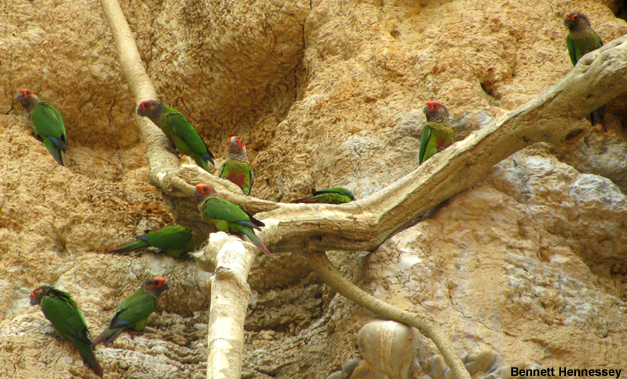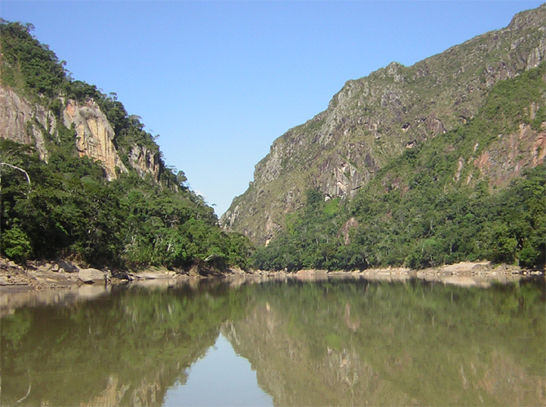Chalalan Eco-lodge
by Bennett
Hennessey and Lawrence Rubey
 Chalalan is one of the most popular more higher priced rainforest tourist lodges in Bolivia, and for many people their claim that they have visited Madidi National Park. But some main points need to be understood. The lodge is poorly placed in a tropical forest rain shadow- a drier area of forest that has low species diversity and abundances. If you want high species diversity and abundances, we suggest you visit one of the deep inside lodges in Manu- (we have heard excellent things about Los Amigos in Peru). Another option would be Serrania Sadiri soon to have facilities. Chalalan is one of the most popular more higher priced rainforest tourist lodges in Bolivia, and for many people their claim that they have visited Madidi National Park. But some main points need to be understood. The lodge is poorly placed in a tropical forest rain shadow- a drier area of forest that has low species diversity and abundances. If you want high species diversity and abundances, we suggest you visit one of the deep inside lodges in Manu- (we have heard excellent things about Los Amigos in Peru). Another option would be Serrania Sadiri soon to have facilities.
 Chalalan is based up the Rio Tuichi, a smaller Andean based river that undergoes radical water level changes. As a consequence, the 5 to 7 hour boat ride to Chalalan from June to September may require several disembarkations as the empty boat is pushed over the rocky river. But given this, most tourists are very happy with the service, guiding and protected wildlife at Chalalan. With almost 6 years of consistent protection effort through tourism, many mammals are coming back and becoming tame allowing great possibilities for observation. A recent observation of the Giant River Otter on Rio Tuichi is wonderful news for a species that has been locally extinct for 30 years. Chalalan is based up the Rio Tuichi, a smaller Andean based river that undergoes radical water level changes. As a consequence, the 5 to 7 hour boat ride to Chalalan from June to September may require several disembarkations as the empty boat is pushed over the rocky river. But given this, most tourists are very happy with the service, guiding and protected wildlife at Chalalan. With almost 6 years of consistent protection effort through tourism, many mammals are coming back and becoming tame allowing great possibilities for observation. A recent observation of the Giant River Otter on Rio Tuichi is wonderful news for a species that has been locally extinct for 30 years.
Chalalan is within Madidi National Park, very likely the richest park in the
world in terms of avifauna with an estimated 1000 plus bird species (so far
Bennett has only been able to get the list to 905 birds). The bird list
for Chalalan stands at over 300 species with many
of the great Amazonian birds like Red-throated Caracara, Red-necked
Woodpecker, Mealy Parrot, Royal Flycatcher, and many other less common
species likely to be added in the future.
 Chalalan is a comfortable introduction to the sights, sounds, smells and texture of the tropical rainforest. However, bird diversity is not as high as less accessible areas along the first ridge of the Andes- the parts of the uncut forest between Ixiamus and San Buenaventura- the best spot being- Alto Madidi. The lodge offers the necessary creature comforts with rustic yet charming rooms, full board, communal bathrooms (with flush toilets) and showers, solar lighting and even cold beers. Birding starts as soon as one sets foot outside the front door with the lake edge lookout with Neotropical Cormorant, White-winged Swallow, Hoatzin, Cuvier's Toucan and Red-capped Cardinal. The symphony of Neotropical sounds starts up before first light with the ripping sound of the Blue-throated Piping-Guan's wing display, the Barred Woodcreeper's laughing call, and the haunting sounds of the Barred Forest-Falcon. And one is sure to fall asleep to the sounds of Spectacled, Crested and Black-banded Owl. Another advantage of Chalalan is its wonderful trail system that takes the visitor through a variety of different habitats and microhabitats. Chalalan also has a rudimentary guidebook, which includes an accurate bird list based on an in-depth two-month study, description of the trails, a summary of some of the more common animals in the area, and a mammal, and tree checklist for the site. The lodge also offers nature guides, who while not bird guides, are outstanding spotters and patient with birders. Chalalan is a comfortable introduction to the sights, sounds, smells and texture of the tropical rainforest. However, bird diversity is not as high as less accessible areas along the first ridge of the Andes- the parts of the uncut forest between Ixiamus and San Buenaventura- the best spot being- Alto Madidi. The lodge offers the necessary creature comforts with rustic yet charming rooms, full board, communal bathrooms (with flush toilets) and showers, solar lighting and even cold beers. Birding starts as soon as one sets foot outside the front door with the lake edge lookout with Neotropical Cormorant, White-winged Swallow, Hoatzin, Cuvier's Toucan and Red-capped Cardinal. The symphony of Neotropical sounds starts up before first light with the ripping sound of the Blue-throated Piping-Guan's wing display, the Barred Woodcreeper's laughing call, and the haunting sounds of the Barred Forest-Falcon. And one is sure to fall asleep to the sounds of Spectacled, Crested and Black-banded Owl. Another advantage of Chalalan is its wonderful trail system that takes the visitor through a variety of different habitats and microhabitats. Chalalan also has a rudimentary guidebook, which includes an accurate bird list based on an in-depth two-month study, description of the trails, a summary of some of the more common animals in the area, and a mammal, and tree checklist for the site. The lodge also offers nature guides, who while not bird guides, are outstanding spotters and patient with birders.
About an
hour downriver from Chalalan, one passes a series
of exposed cliffs where Red-and-green and Chestnut-fronted
Macaws have dug out nests.This site, called Caquiawara,
is near the junction of the Beni and Tuchi
Rivers. The
cliffs are very prominent on the right (north) side of the river. From
the riverbank, a short trail leads uphill to an overlook. Here one can
watch these impressive macaws fly, call and interact from above, with a
perfect backdrop of dark green forest. The macaw nesting cliffs are
best in either early in the morning or late in the afternoon.
Logistics: To make reservation for Chalalan, contact them through their WEB page at
(www.ecotour.org) or E-mail (Chalalan@cibol.rds.org.bo)
and telephone (519) 892-2419. Bird Bolivia (birdbolivia@birdbolivia.com) can do this for you if you are having problems getting an email response. Chalalan has an
office in La Paz and Rurrenabaque. In Rurre, the Chalalan office is on calle comercio (the only paved street) near to the central plaza. Rainforest birding
is always far more interesting with a trained birding guide, and it is worth
trying to arrange such a guide in advance to make the most of your trip. We
highly recommend seeking out Sandro Valdez as you
bird guide, a very compentent bird guide. Be warned
that the package sale is not always clear. Many times the boat trip can take
6-8 hours. There have been complaints of a 3 day trip sold tourists in
La Paz, which consisted in a
night in Rurrenabaque, a full day trip in the boat, a day at Chalalan, and leaving the next day early for a full days
boat trip back to Rurrenabaque. You need to make sure all the trip details
and prices are clear when visiting the lodge.
Any trip to Chalalan can include a stop at the Caquiawara macaw cliffs, but Chalalan staff members are occasionally reluctant to offer this interesting stop. You may want to insist that you want this as part of your tour when booking in Rurrenabaque.
We advise to avoid the long boat trip from Rurre to Chalalan. Try to take on a trip that goes to Serrania Sadiri to catch some of the great canopy foraging flocks in this foothill forest (something that should be noted here, is that people pay big money to go to these lodges with a few metres of canopy walkway, when foothill forest has most of the Amazonian species, and the whole place is one big canopy walkway. Just run up hill for a few seconds and you are looking into the canopy at a species normally impossible to see). From there, travel to San Jose de Uchupiamonas, to visit and see their attractions, and then from San Jose, you can take a pleasant boat ride down to Chalalan, and at the end a return boat trip to Rurre. What I would suggest is insisting on this in the Chalalan office- they will want to avoid such complicated tourists demands, but as they say here, anything is possible in Bolivia.
Be warned
that Amazonian forest birding in Bolivia can be less productive from January
to May, as this is the end of the breeding season and many birds are not in
song. Also in June and July brief winter cold spells (called suarazos) can really slow down the bird activity and if a
suarazo coincides with your visit, you are likely
to be disappointed. The Forest is best from September to November when many
species are singing and breeding activity is starting.
Chalalan Bird List |

